Back in 1994 I wrote my first grad school paper on the pioneering 1920s jazz guitarist Eddie Lang, and I really went to town on the research. I interviewed several record collectors and Lang enthusiasts in person, scoured the libraries for any material that I could find, and at one point even restrung my long-suffering Yamaha acoustic with Lang's favored gauges, .015, .018, .030, .036, .048 and .075. This was an extremely heavy set of strings, a far cry from my usual acoustic gauges, starting at .013. This set of strings used a wound second string (!) and a bass string for the low E. I've never forgotten the robust rumble that emanated from that plywood box for those few weeks, though. Lang used heavy strings to get more volume from his acoustic L-5, his only chance to be heard over the din of the dance bands that he regularly played with. It's reputed that Gibson supplied him with new guitars every couple of years because of the increased tension of those draconian strings, and I don't doubt it. But there was something in that tone for which I'll always pine.
Stevie Ray Vaughan certainly understood the value of a stout set of wires. .013, .015, .019 (unwound), .028, .038 and .058 were his usual poison, though he experimented with a .018 to .075 set at one point. He certainly had a huge tone, thanks in no small part to his giant strings and his penchant for tuning down a half step. I've strung up a few Strats with heavies in my time in short-lived attempts to get Stevie's Texas-sized tone, but always slunk back to my mainstay .010-.046 sets. To play strings of that tension and thickness on a regular basis required a commitment that I was not ready to make. I keep my Epiphone archtop strung with .013-.058 flatwounds, but let's face it, bending strings more than a half-step in jazz is basically illegal. Acoustic guitar - the same. But on the solidbody electrics, it's .010 all the way.
In the other direction, I used .009s and even .008s for a time when I was young and dumb. Even in the fog of adolescence I knew that my tone was mealy-mouthed, though. Thus the compromise of string gauges. Lighter gauges are easier to press down, bend and pick but heavier gauges have the sturdy tone that can't be simulated with electronics. As I love to say, physics doesn't lie. A thicker string sends a stronger signal to the pickups and thus begins a toneful journey through the signal chain, just as Lang's heavy gauges drove the arched top of his L-5 in the pre-electric days.
Remembering Extraordinary Luthier Ken Parker - August 25, 1952 – October 5,
2025
-
*Ken Parker and Parker Fly*
Ken Parker built his first archtop guitar in 1974. This was long before he
rose to fame with his well known electric guitar...
2 days ago













The difference in volume from string size in an acoustic as opposed to an electric is massive. You're not making a good point with that analogy.
ReplyDeleteThe Reverend Billy Gibbons of ZZ Top has used 008's on his guitars for years.
ReplyDeleteConclusion: tone is in the player - not the string gauges.
All else being equal, there is a big tone difference, at least in my experience. I pick hard so .008s are out of the question for me.
ReplyDeleteRe the first comment, I'm not saying that big strings make an electric louder - it's really immaterial how much acoustic volume a string has on an electric guitar. But they do send different frequencies to the pickup, which yields a subjectively 'bigger' tone.
ReplyDeleteI'm also a 010 person all the way. Nowadays, when I pick up a guitar with 9s or 8s my hands just down really know how to play them, any attempt at a bend will go 2 or 2 and a half steps =S
ReplyDeleteI find little strings fun to play for a minute, then I want something that I can feel under my fingers. But that's just because I'm used to .10s.
ReplyDelete